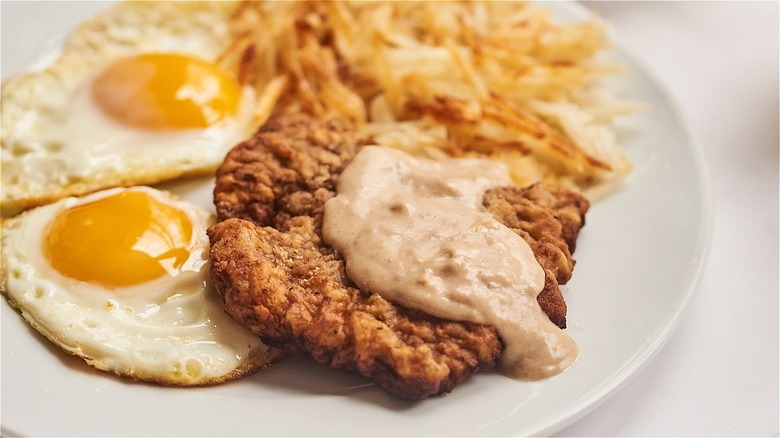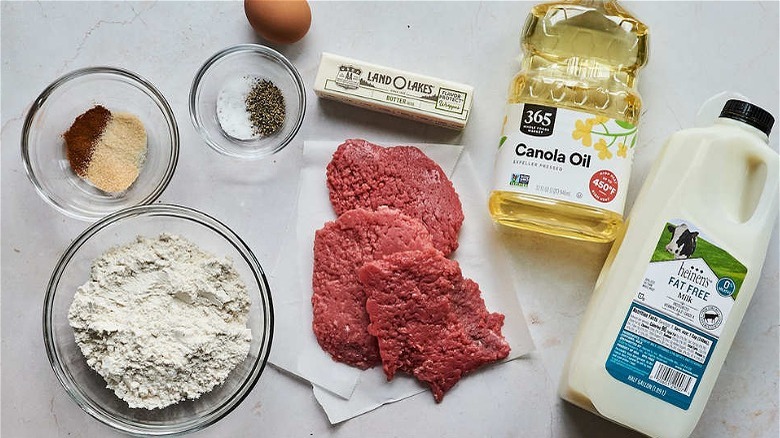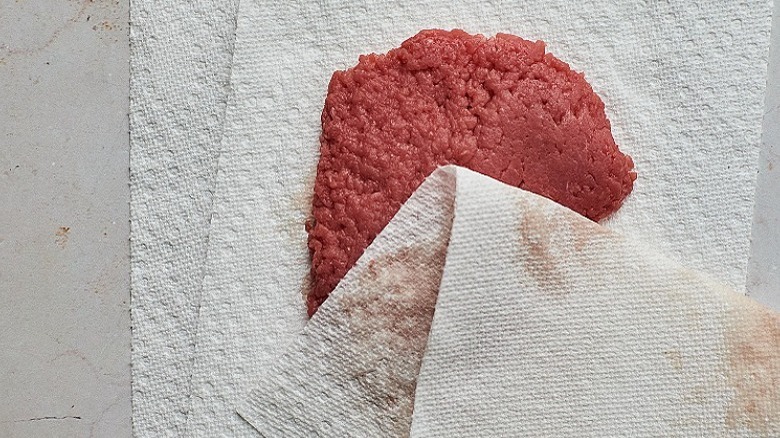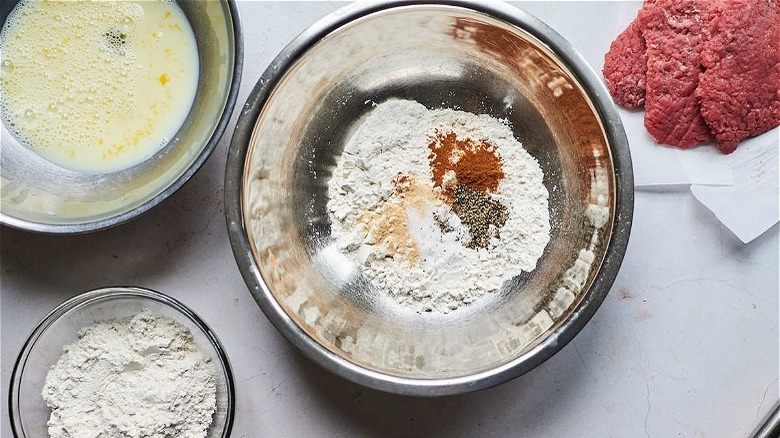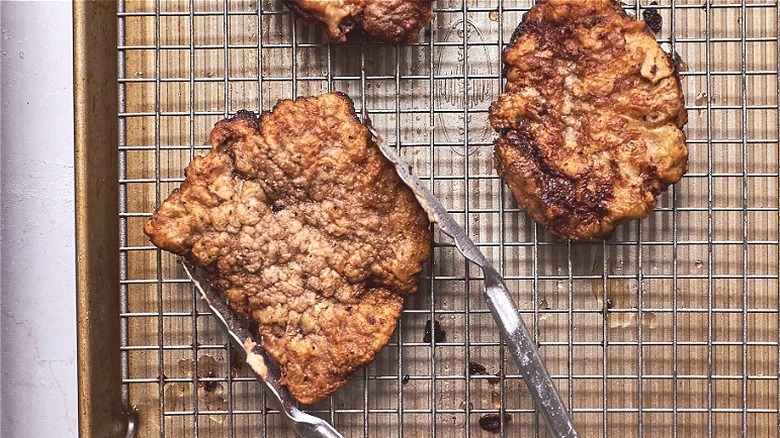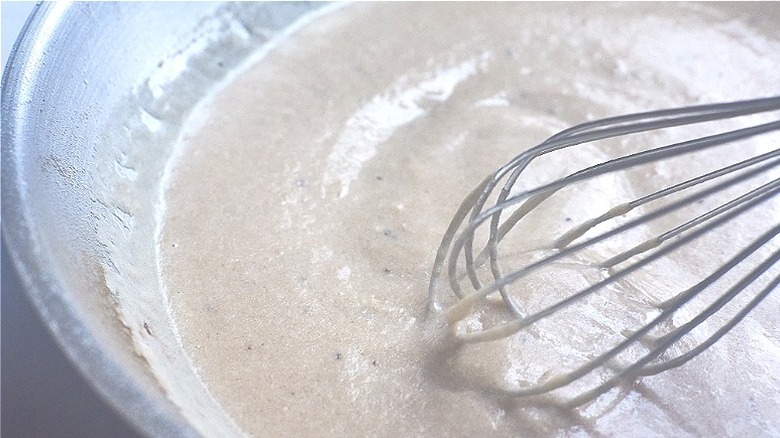Diner-Style Chicken Fried Steak Recipe
Everyone knows that the best diners have crispy chicken fried steak on the menu. Paired with made-to-order eggs, crispy hash browns, and creamy gravy, there isn't a better or more filling breakfast. Chicken and country fried steaks are popular in Southern American states for any meal, and are often served with mashed potatoes and greens as a dinner entrée. Thin, tenderized steaks are coated in flour, milk, and eggs, and fried – like chicken – in oil until crispy, varying slightly from its wiener schnitzel cousin that's coated in breadcrumbs. The breakfast version served across the nation is hardly different, except for the gravy, usually a white peppered sauce, that's served alongside breakfast classics.
Chicken fried steak seems like a project that would take far more energy than desired on sleepy Sunday mornings, but it can actually be made before the coffee's done brewing. While quick and easy, it does require a few important steps to avoid a soggy, tough mess. Developer Michelle McGlinn shares the tricks for getting a perfectly crispy chicken fried steak with easy, creamy gravy below. From the type of pan used, to the amount of oil it's cooked in, each step is important to keeping the steak moist, and the breading crispy. It's tricky at first, but once you master it, you'll be whipping up chicken fried steak (almost) every morning.
Ingredients needed for diner-style chicken fried steak
To make this recipe, start with cube steaks. Cube steaks are inexpensive, tenderized pieces of thin steak that look almost like patties of ground beef. They are located near the steak in the grocery store, and are usually sold in packs of 4 or 6. If you can't find cube steaks, the next best thing is a thin-cut eye of round, but you will have to use a tenderizer (the little spikey hammer) before adding any breading.
With either cut, you'll need salt to dry the steak, then flour for the first and last layer of breading. In between coats of flour, you'll need a little bit of milk, and an egg to bind the flour to the steak. Season the second coating of flour with cayenne, garlic powder, onion powder, and black pepper for flavor. You'll need a neutral oil, like canola for frying the steaks, and from there, you'll just need butter, extra flour, and a little milk to make the gravy.
Dry the steaks
This step seems skippable, but it's arguably the most important part of frying the steaks. To prevent the breading from sliding off while frying, you have to get the steaks as dry as possible first. This differs from chicken because beef shrinks and releases liquid while it cooks, which steams underneath the flour, lifting it off the meat. Think of a hamburger: the patties are always smaller and juicier after cooking.
To do this, put the cube steaks between several layers of paper towels, and firmly pat dry. Sprinkle with 1 tablespoon of salt, and let the steaks rest while prepping the breading stations, then firmly pat dry again.
Prep for breading stations
Assemble 1 bowl with 1 cup of flour. In another bowl, whisk together the egg, and ½ cup milk, and set aside. In a third bowl, whisk together another 1 cup of flour, cayenne, onion powder, garlic powder, 1 tablespoon salt, and black pepper. Once those are ready, heat up a cast iron skillet with about ¼-inch of oil. You want enough oil that the steaks fry on both sides, but not so much that the steaks are submerged. You want to use a cast iron, or otherwise heavy-bottomed skillet, so that the oil heats evenly, and stays hot while adding the cold steaks.
When the oil is hot and ready, pat the steak dry again, and start breading. You will know the oil is ready when you drop some flour into the pan, and it starts to sizzle. First, dip it in the flour and shake off the excess, then dip it quickly into the egg mixture, shaking off any excess. Finally, firmly press the steak into the seasoned flour, coating each side completely, then lightly shaking off the excess.
Fry the steaks
This step takes the most time to perfect. You want the oil perfectly hot so that the flour coating gets crispy, but not too hot that it burns. If the breading comes out soggy or wet, the oil is not hot enough. If it is very dark brown or black, the oil is too hot. Try not to touch the steak when cooking, until the breading is very golden brown. Cook for 3 to 4 minutes on each side, then remove the steaks, and place on a wire rack with a sheet pan underneath to let the juices drip off. Repeat with each steak, being careful not to crowd the pan.
Make a quick gravy to serve
Many southern cooks will swear by using pan drippings to make the gravy, but most diners will use a simple white pepper gravy to complement the steak. While you can start with lard, grease, or drippings, this recipe starts with plain unsalted butter. Melt the butter into a small skillet over medium heat, and whisk in 2 tablespoons of flour, cooking until golden brown, about 1 to 2 minutes. Whisk in 1 cup of milk, a little bit at a time, and bring to a simmer, until the gravy is at a desired thickness. Whisk constantly to avoid burning. Add a generous amount of black pepper and salt to taste, then remove from the stove.
Diner-style chicken fried steak can be served with sunny-side-up eggs, crispy golden hash browns, fresh coffee, and toast. Serve immediately, or store in the oven on the lowest setting to keep warm until ready to eat. Leftovers aren't ideal, but can be saved in an airtight container in the refrigerator for up to 4 days, and brought back to life in an air fryer or conventional oven.
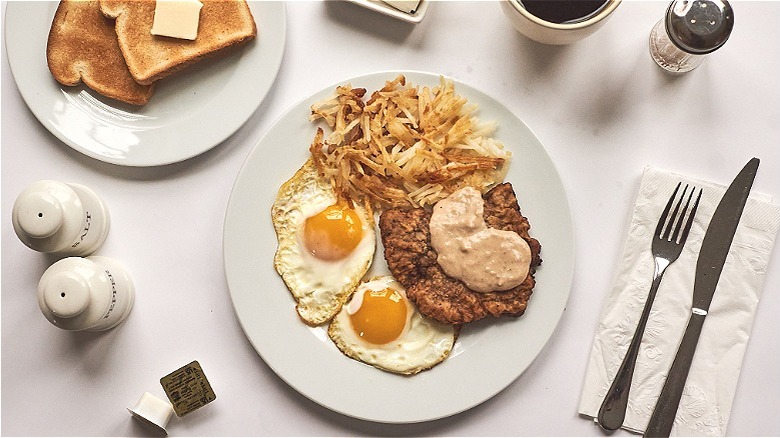
- 4 cube steaks
- 2 tablespoons salt, divided, plus more to taste
- 2 cups, plus 2 tablespoons, all-purpose flour, divided
- 1 egg
- 1 ½ cups milk, divided
- 1 teaspoon cayenne
- 1 teaspoon onion powder
- 1 teaspoon garlic powder
- 1 teaspoon black pepper, plus more to taste
- ½ cup canola oil, or more as needed
- 2 tablespoons butter
- Put cube steaks between 2 paper towels, and press out any moisture. Pat completely dry. Sprinkle with 1 tablespoon of salt, and set aside while setting up the breading stations. Firmly pat again to remove any moisture.
- Assemble 1 bowl with 1 cup of flour, and set aside. In another bowl, whisk together the egg and ½ cup of milk, and set aside. In a third bowl, whisk together 1 cup of flour, cayenne, onion powder, garlic powder, 1 tablespoon salt, and black pepper.
- Heat ¼-inch of oil in a cast iron pan over medium high heat. Heat until a drop of flour sizzles.
- Once the oil is hot, pat the salted steaks completely dry again. Dip them in the flour and shake off the excess, then dip them quickly into the egg mixture, shaking any excess off. Finally, firmly press the steaks into the seasoned flour, coating each side completely, then lightly shaking off the excess.
- Put the coated steak into the hot oil, and fry until golden brown, about 3 to 4 minutes per side. Do not disturb while frying.
- Once golden brown on both sides, remove from the skillet, and place on a baking sheet fitted with a wire rack, or a plate lined with paper towels. Allow to drain. Repeat with each steak, being careful not to crowd the pan.
- To make the gravy, melt the butter in a small skillet over medium heat. Whisk in 2 tablespoons of flour, and cook until light brown, about 1 to 2 minutes.
- Slowly pour in 1 cup of milk, whisking constantly, and bring to a simmer until thick. Season to taste with salt and pepper, and serve.
| Calories per Serving | 671 |
| Total Fat | 51.1 g |
| Saturated Fat | 13.2 g |
| Trans Fat | 0.3 g |
| Cholesterol | 181.7 mg |
| Total Carbohydrates | 9.2 g |
| Dietary Fiber | 0.6 g |
| Total Sugars | 4.8 g |
| Sodium | 728.0 mg |
| Protein | 42.3 g |
